Everyone squats. There are very few exercises that athletes and gymgoers alike, regardless of their sport or goal, all practice in some form. But the squat is one of them. Barbell back squats — which means holding the resistance across your upper back — are just about the best compound exercise you can do for your lower body. Whether you’re looking to increase strength, build muscle, or bulletproof your body against anything life throws at it, you should be squatting. Here’s how to master your back squat form.
Editor’s Note: The content on BarBend is meant to be informative in nature, but it shouldn’t take the place of advice and/or supervision from a medical professional. The opinions and articles on this site are not intended for use as diagnosis, prevention, and/or treatment of health problems. Speak with your physician if you have any concerns.
Video Guide
If you’re a visual learner, check out this seven-step instructional video on how to properly back squat from world-record-holding powerlifter Taylor Atwood and former BarBend training editor Jake Boly:
How To Do the Back Squat
Before you step into the squat rack, know that there’s more than one “style” of squatting. Powerlifters rely on the low bar squat — resting the barbell across their upper back and shoulders, rather than directly on their traps — while the “standard” technique places the bar up higher. This guide will instruct you on how to perform the “high bar” squat.
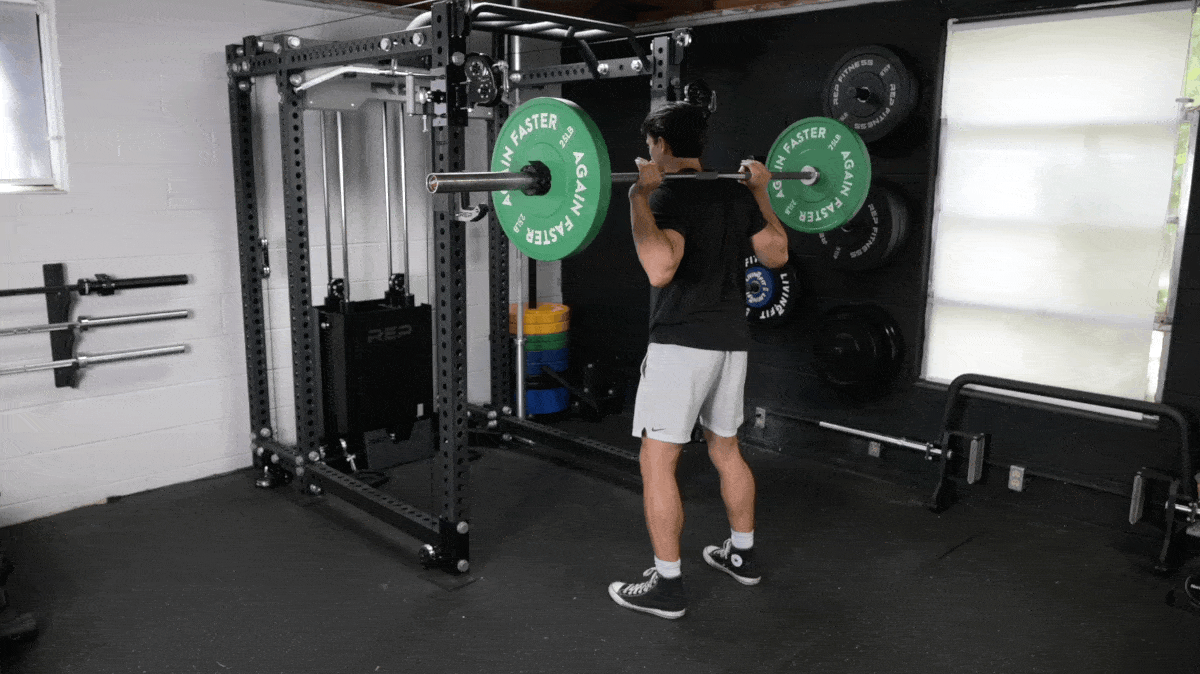
Equipment Needed: To perform back squats, you’ll need a barbell and some weight plates, as well as a squat or power rack to hold the bar in. Other types of gym equipment that you may want to consider are knee sleeves, weightlifting shoes, and perhaps a weightlifting belt.
- Step 1 — Start by stepping under a barbell (supported in a squat rack), setting a firm foundation by flexing your core, and preparing to lift the barbell out of the rack.
- Step 2 — With your hands clasping the bar just outside your shoulders, take a breath and step out of the rack with the bar on your back.
- Step 3 — Situate your feet in your squatting stance. If you aren’t sure, start by placing your feet just wider than your hips and turning your toes outward slightly.
- Step 4 — Take a new breath and think about expanding your core with air in all directions. Pick a spot directly in front of you and focus your gaze on it.
- Step 5 — Squat down by unlocking your knees and hips simultaneously and slowly sitting straight down. Keep your chest up, but allow your torso to lean forward as needed. Sink down until your hips drop below your knees, and then push through the floor to stand back up.
Coach’s Tip: There’s no reason to overcomplicate the squat. Stabilize your torso, then think about slowly dropping your pelvis down to the ground as low as you can comfortably go.
Modifications
- Make It Harder: The deeper you squat, the more muscle you activate, but the harder the move gets. (1) You can also add a pause in the bottom to really double down on the difficulty.
- Make It Easier: If you have trouble holding the barbell due to restrictions in mobility, look for a safety bar in your gym. You can also make the squat more stable by doing box squats, sitting down onto a stable surface like a bench or plyo box, rather than relying solely on your strength to stand back up.
Back Squat Variations
If you want to mix up your squat workouts, try one of these back squat variations instead of the standard lift. These moves adjust the difficulty and can help you access different muscles, too:
1 ½ Squat
[Read More: Half Squat vs Full Squat – Which Should You Be Doing?]
Why Do It: The 1 ½ squat entails performing a full rep, then a half rep, then finishing. This variation is great for increasing time under tension, improving postural positions, and sharpening mental awareness during the squat. It also emphasizes the stretched position of your quads and glutes, which has been shown to lead to more muscle growth. (2)
Equipment Needed: There’s no special equipment needed for this variation, though you’ll want to have a rack with safety arms or catches in case you fail a rep.
- Set up and begin your squats as you normally would.
- As you come out of the bottom position of the squat, rise until you’re about half way up, then switch gears and descend again back into the bottom.
- At the bottom, stand up all the way again. That’s one-and-a-half-reps.
Pause Squat
Why Do It: The pause squat is identical to the standard back squat in every way save one — you come to a full stop in the bottom of your range of motion. Pause squats are great for developing isometric strength, improving your hip or ankle mobility, and teaching yourself how to develop explosive power.
Equipment Needed: There’s no extra equipment needed to perform back squats with a pause.
- Set up in your standard squat position and prepare to descend.
- Brace your core and sit down into your squat as low as you comfortably can.
- When you reach the bottom, come to a full stop and remain motionless for a second or two.
- Then, explosively and forcefully push out of that paused position and stand back up.
Low Bar Back Squat
[Read More: Big Benefits of the Low-Bar Back Squat]
Why Do It: There’s a long debate going between low bar vs. high bar back squats, but all you need to do is think of them as different tools to accomplish the same job. The low bar squat is favored in the sport of powerlifting because it reduces your range of motion and shifts your muscle engagement slightly away from your quads and toward some of the muscles in your posterior chain. (3)
- Approach a bar in a squat rack and grab it with a wider-than-shoulder-width grip.
- Step under the bar and point your elbows back behind you. This will create a small “shelf” across the backs of your shoulders that you can wedge the bar into.
- Once the bar is secure, unrack it and step backward into your normal stance. The low bar position will tilt your torso forward slightly.
- From here, inhale, brace your core, and descend as you normally would. Allow the bar position to change the angle of your torso; you will lean forward more than usual.
Back Squat Alternatives
If the back squat isn’t clicking for you, don’t worry, there are several alternative exercises to the back squat you can do instead. Here are a few examples:
Front Squat
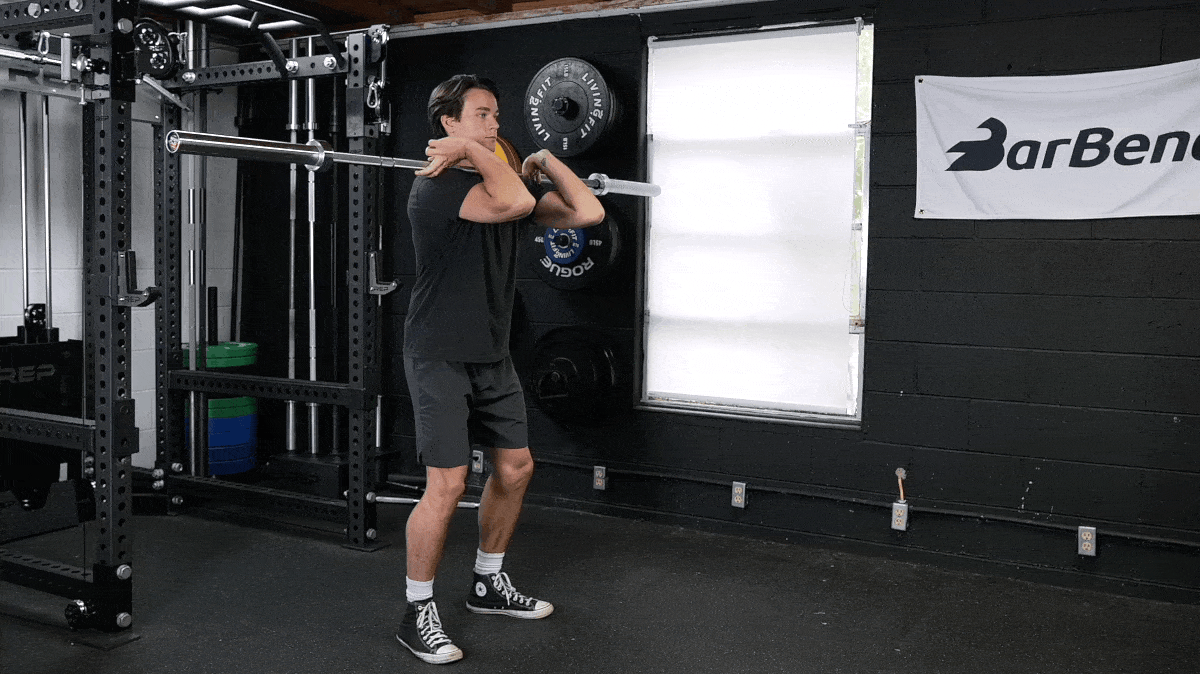
Why Do It: There’s a lot of chatter about the front squat vs. the back squat; they’re less different than you might think. Holding the bar in the front rack position instead of on your back will challenge your upper back and core more than the back squat, while also limiting the weight you can use. However, what you do with your lower body is pretty much the same.
Equipment Needed: All you’ll need for front squats are a bar and a rack. If you’re experiencing wrist pain, you may want to get ahold of a pair of wrist wraps as well.
- Hold a bar in the front rack position by grabbing it with a shoulder-width grip and then “flipping” your elbows down, under, and up. The bar should rest in the small divot between your neck and your shoulders, without pressing directly onto your collarbone.
- Step out of the rack and find your normal squat stance. Keep your elbows up high, pointing mostly forward.
- Brace your core, maintain a “tall” torso, and sit straight down as low as you’re able.
Modifications: The front rack position can be difficult to reach for some people depending on their mobility or body type. You can replicate it by holding the bar with just two fingers rather than a full grip, using a cross-arm position, or even tying a pair of lifting straps to the bar and holding those instead.
Goblet Squat
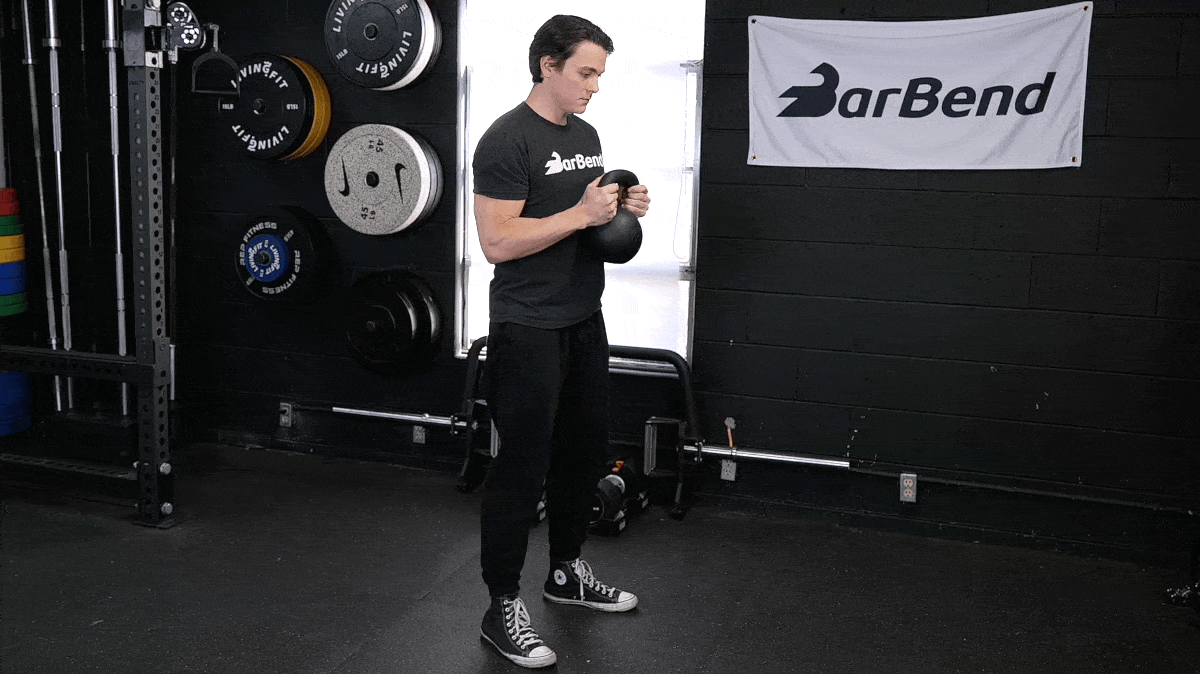
Why Do It: The goblet squat is a fantastic back squat alternative for the beginner that wants to nail down their movement mechanics. Besides being a fantastic precursor for back squats, the goblet squat is a great exercise to do during warm-ups and when teaching torso positioning.
Equipment Needed: All you’ll need for goblet squats is a heavy dumbbell or kettlebell.
- Grab the weight. If you have a dumbbell, place your palms against the underside of the circular plate and wrap your fingers around the rim. For a kettlebell goblet squat, clasp your hands around the bottom of the sphere.
- Hold the weight aloft at chest height. Your forearms should be mostly vertical with your elbows toward the floor. The weight should be around the level of your collarbone.
- Inhale, brace your core, and squat down low with your normal stance.
Modifications: The goblet squat provides a counterweight, which should improve your balance as you squat. If you’re feeling unsteady, you can also squat down onto a plyo box or weight bench rather than squatting freely.
Bulgarian Split Squat
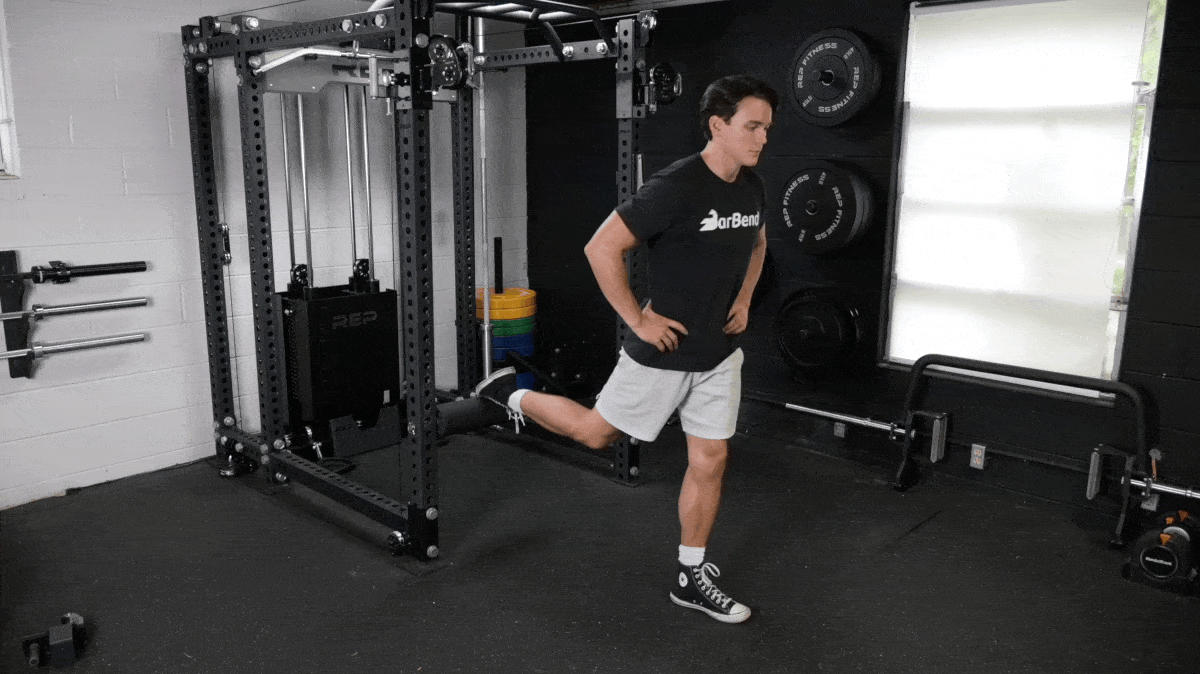
[Read More: Try Out the Best Split Squat Variations For Every Experience Level]
Why Do It: Bulgarian or rear-foot-elevated split squats, allow you to work your legs independently from one another. This unilateral leg exercise will expose any imbalances in muscle strength or stability that you may not notice during the back squat. Unilateral squats are great for remedying said imbalances as well. (4)
Equipment Needed: You can do Bulgarian split squats with any sort of weight, or even none at all. But what you will need is a weight bench to place your back foot on; you can also use a plyo box or even a barbell suspended low in a squat rack.
- Place your back leg onto a bench or a plyo box and step out with your working leg.
- If you aren’t using any weight, place your hands onto your hips or hold them out to your sides to help your balance.
- Brace your core and sit down and back with your hips as low as you can; stop just before your back knee touches the floor.
Modifications: If you’re having trouble with your balance, set up for your Bulgarian split squats near something stable like a power rack or pillar and hold it gently as needed. This will allow you to do your squats without falling over.
Who Should Do the Back Squat
The squat isn’t the end-all, be-all of resistance training, but it’s close. The movement pattern is one of the most fundamental skills available to human beings, making it as close to a gymgoing essential as an exercise gets.
Powerlifters
The squat is the first of three competition lifts that comprise a powerlifter’s Total, followed by the bench press and deadlift. Powerlifters almost exclusively employ the low bar squat as it allows the athlete to achieve a heavier one-rep max.
Strongman Athletes
Squatting isn’t as prominent in strongman as it is in Olympic lifting or powerlifting, but you still need strong legs. Challenges like the Atlas stones absolutely necessitate explosive quad strength, so strongmen should dedicate some of their training resources to building up their back squat.
Weightlifters
The competition lifts for Olympic lifting are the snatch and clean & jerk. The high bar back squat is critical for both leg strength and torso posture as an accessory, while the front squat is directly transferable to your performance in the clean.
CrossFitters
Competitive fitness training and competitions, like the CrossFit Games or otherwise, involve many movements such as the snatch, clean and jerk, jumping, and other upright squatting movements. They also involve a good deal of pulling movements that require serious hip and back strength.
Bodybuilders
If you’re pursuing the “perfect” physique, lifting weights is all about finding which leg exercise best suits your body and gives you a good mind-muscle connection.
However, load and tension are still important for muscle hypertrophy. The back squat definitely has a place in any good leg day, but you shouldn’t force the issue if you don’t connect with the movement.
Back Squat Sets and Reps
As the back squat is relevant for just about every flavor of fitness enthusiast, how you go about programming it matters a great deal with respect to what kind of returns you’re looking for.
Here are a few different ways to program the back squat, but take note — the more specific your goals become, the more nuanced your squat training will be as a result. Use these as what they are: generalized prescriptions.
- To Build Muscle: 4 to 5 sets of 6 to 8 reps with a moderately heavy weight.
- To Gain Strength: Anywhere from 3 to 8 sets of 3 to 5 reps with a heavy but manageable weight.
- As a Beginner: 3 sets of up to 10 reps with a light weight to work on technique.
Warm-Up for Squats
The dynamic warm-up protocol you follow for your squats will depend on your specific needs; there’s no one-size-fits-all-template. However, everyone should focus on a few key elements when they warm up: Raising your core temperature, activating some key muscles, and practicing the movement pattern with light weights are all considered integral to a good warm-up routine. (5) Here’s an example warm-up for the back squat:
- 5 to 10 minutes of low-intensity cardio on the treadmill, exercise bikes, stair climbers, or elliptical.
- 1-2 sets of unweighted single-leg squats, Romanian deadlifts, or hip thrusts.
- 2 to 5 ramp-up sets of squats beginning with just the barbell.
Benefits of the Back Squat
Below are three main benefits of the back squat. It’s important to note that back squats are one of the most beneficial exercises (when done correctly and not in excess) for strength, sports performance (especially in strength and power sports), and leg strength.
Improved Leg Strength and Size
The back squat, like the deadlift, builds serious leg and back strength as it engages all major muscles in your legs — big and small — and allows you to load the body with significantly more weight than what can be achieved with other moves like lunges, goblet squats, and leg extensions.
[Read More: Science-Backed Benefits of Squats You Should Know About]
More muscle is aesthetically pleasing. After all, no one (well, most people) wants to look like Hercules up top and the Road Runner from the waist down. Also, while a bigger muscle doesn’t necessarily mean a stronger muscle, it does mean you have the capacity for more strength.
(Way) More Power
The squat patterning and performance outcomes have been linked to an athlete’s ability to jump higher and sprint faster. One study in the British Journal of Sports Medicine found a strong correlation between squats (well, half squats) and jump height. (6)
If you’re an athlete, you may want to (strongly) consider adding squats to your strength training routine.
Improved Movement
Almost everyone engages in squats, or some form of them, daily. Where do you think the expression “pop a squat” comes from? When it comes to moving, if you don’t use it, your body will eventually lose it, so to speak.
Your joints need to engage in a specific pattern on the regular to become proficient at it, and so back-squatting will help your ankle, knee, and hip joints get better acquainted with this fundamental movement pattern, which is a good thing if you don’t want to be stuck on the toilet in your 80’s.
Back Squat Muscles Worked
Below are the muscle groups involved with the back squat. The back squat is a very taxing compound exercise that takes just about every muscle in your lower body to the limit.
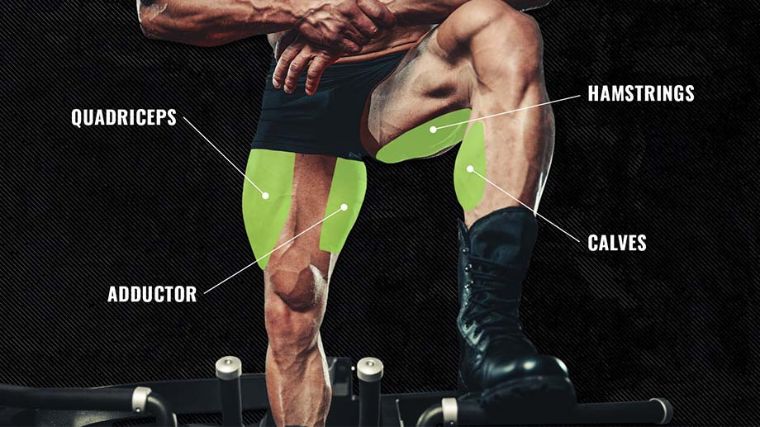
Quadriceps
The quadriceps extend your knee joint and, as a result, are the prime mover in every form of squat you perform. The deeper you sit into the squat posture, the more your knee bends. As such, you’ll generally get more quad engagement the deeper you squat, so don’t skimp out on your depth.
Glutes
Your glutes help control the rate at which you descend into the squat. More importantly, they help you extend your hips and return to a standing posture. Your gluteus medius (and minimus, to a degree) also play a role in controlling the angle and rotation of your thigh so your technique stays on-point.
Spinal Erectors
The spinal erectors work to maintain an upright torso position in the back squat. Like the front squat, the erectors work to maintain a vertical torso position to allow for a more quadriceps-focused high-bar back squat. Your erectors are stressed more in the low bar back squat than when working high bar, which is worth considering when you’re picking your preferred squat.
Core
The musculature of your core enables the squat. If your legs are the engine, your trunk is the frame that allows you to produce power and move well. You’ll notice a great degree of abdominal engagement if you squat with a high bar or front position, as your abs need to work double-time to maintain a vertical posture.
Common Back Squat Mistakes
The back squat is equal parts simple and complex. It’s one of those exercises that feels insurmountably difficult when you’re first learning but, over time, can become as natural as walking. Still, there are a few pitfalls to be wary of, especially if you’re just finding your proverbial footing in the movement.
Half-Squatting
If you’re not a powerlifter, how low you squat doesn’t technically matter. That said, when it comes to depth, more is more, almost universally. Many learners will cut their descent short on the back squat out of fear, movement anxiety, or inflexibility. You should strive to sink as low as you can while squatting unless you have a restriction or injury.
Hips Shooting Up
When you reverse the descent and push yourself out of the bottom of the squat, the angle of your torso should remain consistent from start to finish. If your back is stronger than your legs or you try to stand up too quickly, you run the risk of keeling over as your pelvis shoots out behind you.
[Read More: Are You Making These Squat Mistakes? Here’s How to Fix Them]
This can throw you off balance, screw up your “groove”, and sap you of your power output. Stand up with your hips and legs equally.
Overusing Your Glutes
Believe it or not, it is possible. The back squat is a phenomenal glute builder, but there’s no reason to over-emphasize it. You may occasionally see people stand up out of their squat and really thrust their hips forward at the top, squeezing their bums as hard as they can. This may look effective, but it doesn’t work your glutes any harder. If you want to increase glute activation on the squat, make sure you’re breaking parallel at minimum.
Shifting Your Weight
Most people don’t need to adjust, tweak, or tinker with their foot pressure in the squat. Your goal is to be balanced at all times, with your body’s weight evenly-distributed across your whole foot.
As you learn to squat, you may find that you shift forward onto your toes or backward onto your heels — strive to stay in the middle the whole way through.
Frequently Asked Questions
Who should back squat?
The back squat is an interesting exercise because it holds benefits for every lifting population, however, not everyone needs to perform this exercise to progress. However, if you’re able to and comfortable in doing so, then regularly using the back squat is a fantastic tool to develop total body musculature.
What are the benefits of the back squat?
The back squat holds multiple benefits for every fitness enthusiast. Some of the most popular benefits include:
– Improve lower back strength.
– Increase lower body power.
– Build a strong core/torso (due to stabilization of weight).
– Sharpen body awareness and coordination.
– Build resilience in sport and daily life.
Can beginners back squat?
Absolutely! However, it’s worth noting that true beginners should seek out a coach when first learning the back squat. It’s never a bad idea to have someone watch and critique your form when starting out, but yes, everyone — ever true beginners — can back squat.
What muscles do back squats work?
The back squat works a variety of muscles and this is why most call it the “king” of the lifts. Some of major muscle groups squats work include:
Primary Muscles
– Glutes
– Quads
– Adductors
Secondary Muscles
– Obliques
– Rectus Abdominis
– Erector Spinae
– Calves
– Hamstrings
– Traps
References
- Cabral, Lissiane & Lima, Leonardo & Cabido, Christian & Fermino, Rogério & Oliveira, Saulo & Medeiros, Alexandre Igor & Barbosa, Luis & Souza, Thiago & Banja, Túlio & assumpção, Claudio. (2023). Muscle Activation during the Squat Performed in Different Ranges of Motion by Women. Muscles. 2. 12-22. 10.3390/muscles2010002.
- Pedrosa, G. F., Lima, F. V., Schoenfeld, B. J., Lacerda, L. T., Simões, M. G., Pereira, M. R., Diniz, R. C. R., & Chagas, M. H. (2022). Partial range of motion training elicits favorable improvements in muscular adaptations when carried out at long muscle lengths. European journal of sport science, 22(8), 1250–1260.
- Glassbrook, Daniel & Helms, Eric & Brown, Scott & Storey, Adam. (2017). A Review of the Biomechanical Differences Between the High-Bar and Low-Bar Back-Squat. Journal of strength and conditioning research. 31. 10.1519/JSC.0000000000002007.
- McCurdy K, Langford G. The relationship between maximum unilateral squat strength and balance in young adult men and women. J Sports Sci Med. 2006 Jun 1;5(2):282-8. PMID: 24260001; PMCID: PMC3827570.
- Resende MA, Vasconcelos Resende RB, Reis GC, Barros LO, Bezerra MRS, Matos DG, Marçal AC, Almeida-Neto PF, Cabral BGAT, Neiva HP, Marinho DA, Marques MC, Reis VM, Garrido ND, Aidar FJ. The Influence of Warm-Up on Body Temperature and Strength Performance in Brazilian National-Level Paralympic Powerlifting Athletes. Medicina (Kaunas). 2020 Oct 14;56(10):538. doi: 10.3390/medicina56100538. PMID: 33066417; PMCID: PMC7602261.
- Wisløff U, Castagna C, Helgerud J, et alStrong correlation of maximal squat strength with sprint performance and vertical jump height in elite soccer players British Journal of Sports Medicine 2004;38:285-288.
Featured Image: Riley Stefan